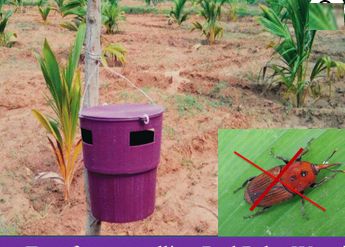-
indianagrifarm2015@gmail.com -
View Mobile Number
Agricultural Trap
Leading Manufacturers, Exporters, Wholesaler, Retailer of Red Palm Weevil Trap and Rhinoceros Beetle Trap from Kanyakumari.
| Business Type | Manufacturer, Exporter, Supplier, Retailer |
| Material | Plastic |
| Ideal for | Control of Red Palm Weevil |
| Trap Shape | Round |
| Lure Trap other Name | Bucket Trap |
| Color | Purple |
| Beetle is Widely Distributed In | Coconut Plants |
Preferred Buyer From
| Location | Worldwide |
Product Details :
- Several trials conducted by the Coconut Development Board, Kochi, have indicated that pheromone traps are ideal for the control of Red Palm Weevil, a serious pest in coconut plantations.
- The beetles attack the coconut trees and damage the growing parts of the palms. One beetle damages one coconut palm in its life cycle.The insect is named Red Palm Weevil because the male bears a horn on the middle of its head.
- In India, the beetle is widely distributed in coconut plantations.The life cycle of the beetle lasts for about six months. Adult beetles have a life span extending to 200 days or more under favourable conditions. The insect attacks the crown of the coconut tree and damages the spindle and unopened leaves.
- This lure trap also known as bucket trap is a proven method to trap and kill the beetles. It is a specially designed bucket trap, which is supplied along with a lure. The lure is placed inside a lure holder attached to the lid of the bucket.
- The bucket has five rectangular windows cut about 3 cms below its rim.
How it works:
- Jute cloth or thread is stuck to the exterior side of the bucket to provide grip to the attracted beetles, which climb on them and enter into the trap.
- About one fourth of the bucket is filled with water. Beetles attracted by the RB-lure will enter the bucket through the entry holes, fall into the water and drown.
- The trap is tied on the coconut trees 3-4 feet from the ground. About eleven traps at the rate of one trap per acre can be placed.
- The traps must be serviced at least once a week for removing the dead beetles and to replace water to compensate for loss due to evaporation.
- “The beetles generally breed in cattle dung pits and other decaying wastes. “The control can be made more effective if the trapping of the beetle is done simultaneously with the treatment of breeding places with pesticides to kill the larvae and eggs,”
| Business Type | Manufacturer, Exporter, Supplier, Retailer |
| Ideal For | Control of Rhinoceros Beetle |
| Rb-lure Trap other Name | Bucket Trap |
| Features | Control the agriculture insect & pest |
| Color | Purple |
| Trap Shape | Round |
| Material | Plastic |
Preferred Buyer From
| Location | Worldwide |
Product Details :
- Several trials conducted by the Coconut Development Board, Kochi, have indicated that pheromone traps are ideal for the control of rhinoceros beetle, a serious pest in coconut plantations.
- The beetles attack the coconut trees and damage the growing parts of the palms. One beetle damages one coconut palm in its life cycle.The insect is named rhinoceros beetle because the male bears a horn on the middle of its head.
- In India, the beetle is widely distributed in coconut plantations.The life cycle of the beetle lasts for about six months. Adult beetles have a life span extending to 200 days or more under favourable conditions. The insect attacks the crown of the coconut tree and damages the spindle and unopened leaves.
- RB-lure trap also known as bucket trap is a proven method to trap and kill the beetles. It is a specially designed bucket trap, which is supplied along with a lure. The lure is placed inside a lure holder attached to the lid of the bucket.
- The bucket has five rectangular windows cut about 3 cms below its
How it works:
- Jute cloth or thread is stuck to the exterior side of the bucket to provide grip to the attracted beetles, which climb on them and enter into the trap.
- About one fourth of the bucket is filled with water. Beetles attracted by the RB-lure will enter the bucket through the entry holes, fall into the water and drown.
- The trap is tied on the coconut trees 3-4 feet from the ground. About eleven traps at the rate of one trap per acre can be placed.
- The traps must be serviced at least once a week for removing the dead beetles and to replace water to compensate for loss due to evaporation.
- “The beetles generally breed in cattle dung pits and other decaying wastes. “The control can be made more effective if the trapping of the beetle is done simultaneously with the treatment of breeding places with pesticides to kill the larvae and eggs,”

